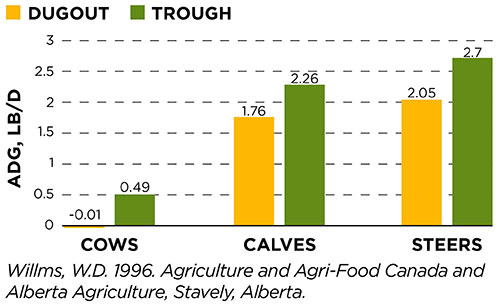Farm ponds may be hurting cattle gains |
| By Michaela King |
|
|
 Water is key for the survival of animals and plants; however, its quality can play just as big of a role for an animal to thrive and grow on pasture. In a Noble News and Views article, Caitlin Hebbert, a livestock consultant for the Noble Research Institute, advises to evaluate your pasture water sources regularly and keep track of how they change through the years. Water is a nutrient, and just like feed, the nutritional value varies depending on overall quality. Many factors can affect how much water a cow consumes, including lactation, activity, and environmental temperatures. Water quality impacts the palatability of water and can also cause cattle to drink less. This leads to reduced feed consumption and less weight gained. Even if something in the water is just slightly off, it can lower how much water animals consume. “Cattle will avoid water contaminated even with as little as 0.005 percent manure by weight,” Hebbert says, “So your ponds are probably less palatable than you think.” She says some of the most common water quality problems include high concentrations of minerals, high nitrogen content, bacterial contamination, large growth of toxic blue-green algae, and accidental spills of gas, pesticides, or fertilizers. Good water isn’t just clean Hebbert notes, “Logic may say: ‘If I have clean ponds with good, clear water and no excess contamination, I should be in the clear.’ But it’s not always that simple.” According to the consultant, the source of the water affects rate of gain in cows as much as water quality. A Saskatchewan study found even though there was no significant difference in water chemistry between two water sources, steers and calves drinking from a trough had a 9 to 10 percent higher weight gain compared to those drinking from a pond. A study done in 1996 compared the average daily gain (ADG) of cows, calves, and steers drinking from a pond (dugout) to those drinking from a trough. As the graph shows, cattle drinking from a trough had significantly higher ADG.  “The aeration that occurs during the pumping process is thought to be one factor contributing to the increase in palatability of water for livestock,” Hebbert says. Additionally, cattle that have access to clean, aerated water spend more time grazing and less time resting than those drinking from farm ponds. The bottom line is that even a well-maintained pond rarely compares to water pumped into a trough. Give your water sources and their quality a thorough evaluation because even the smallest problem can affect how cows perform. “The extra boost in gains per day really adds up,” Hebbert concludes. “Ensuring that clean water is available can definitely pay off in the long run.”  Michaela King Michaela King is serving as the 2019 Hay & Forage Grower summer editorial intern. She currently attends the University of Minnesota-Twin Cities and is majoring in professional journalism and photography. King grew up on a beef farm in Big Bend, Wis., where her 4-H experiences included showing both beef and dairy cattle. |
